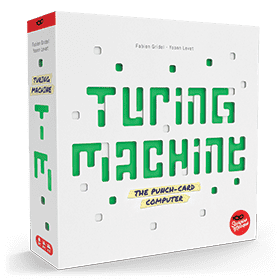Turing Machine
 Turing Machine è un gioco di deduzione affascinante e competitivo. Offre un'esperienza unica di interrogare un proto-computer che funziona senza elettricità o qualsiasi tipo di tecnologia, aprendo la strada a una nuova generazione di giochi di deduzione.
Turing Machine è un gioco di deduzione affascinante e competitivo. Offre un'esperienza unica di interrogare un proto-computer che funziona senza elettricità o qualsiasi tipo di tecnologia, aprendo la strada a una nuova generazione di giochi di deduzione.
L'obiettivo? Trovare il codice segreto prima degli altri giocatori, interrogando abilmente la macchina. Con Turing Machine utilizzerai un computer analogico con componenti unici realizzati con carte perforate mai viste prima.
Il gioco offre più di sette milioni di problemi da combinazioni semplici a combinazioni incredibilmente complesse, rendendo il gioco praticamente infinito!
Numero di giocatori: 1 - 12
Durata della partita: 8 mn
Complessità: 2 / 5
Gioca a Turing Machine e 1194 altri giochi online.
Nessun download, gioca direttamente dal tuo browser.
Con i tuoi amici e migliaia di giocatori da tutto il mondo.
Gratuito.

Gioca a Turing Machine e 1194 altri giochi online.
Nessun download, gioca direttamente dal tuo browser.
Con i tuoi amici e migliaia di giocatori da tutto il mondo.
Gratuito.

Sommario delle regole
Overview
The objective of the game is to be the first player to correctly solve the code, and with the fewest questions asked, or be the only player not eliminated.
Turn
A turn consists of four or five stages, with each stage carried out simultaneously. The stages are:
- Compose
- Question
- Deduce
- End
- Verification (Not in all rounds)
Compose
In this phase, each player decides on a number for each colour/shape. A number may be used for multiple shapes (e.g. three triangles three squares, two circles).
Question
Players pick up to three of the Verifiers and see how their Proposal meets their criteria.
Two Important Notes:
- The Verifiers do NOT correspond to colors and/or shapes. For example:
- Two Verifiers may contain criteria towards the same colour/shape, or
- A single Verifier may ask if Yellow/Square is Even,
- Another Verifier may ask if Yellow/Square is greater than three)
- The Correct and Incorrect answer received does NOT mean the number is right or wrong, but whether or not your proposal passed for that the Verifier.
Deduce
After completing the Verification step, take some time to figure out (but not declare) if you have found the answer.
End
At the end, count to three, then reveal either a thumbs up (if think you know the code) or a thumbs down (if you are not sure of the code)
If everyone pointed down, return to Compose Phase
If at least one person pointed up, move to the Verification Phase
Verification
The correct code will pass the test of ALL verifiers
If one person is correct, they win!
If more than one person is correct, the person who asked the fewest questions wins!
If no one is correct, they are eliminated!
If the second to last person is eliminated, the final player, even though they did not participate in Verification, will win!
Meaning of verifiers
Each of the verifiers tell you that one of the criteria tested is true or not.
Per example if it exist a verifier which tell you if [(b<3) or (y<3) or (p<3)], that assure you that the color tested is <3. By testing 222, in all games that verifier would return true (so it's useless to ask). If you test 225, it can return true or false. If it return false, then p<3. If it return true, then you don't know if b<3 or if y<3 or if both are true. If you test 555, it will always return false (so it's useless to ask).
Mode
Classic
1 card for each verifier.
Extreme
2 cards for each verifier but only one valid criterion.
Nightmare
You do not know which verifier is associated with which verification card.
Strategy (spoilers)
Each verifier is useful and at the end there is a single solution.
If there is a verifier which test if b<y, b=y, or b>y ; and another test if b<yp, y<bp, or p<by, then if y<bp, that makes the first verifier useless. Same for b<yp. So the second verificator is p<by.
If there is a verifier about the numbers of 4s in the combinaisons, and no others verifiers tell you information about purple, then if p=1, you could have another solution by making p=2. Same for 3&5. So p=4.
For more information, check the following page: Tips turingmachine .

